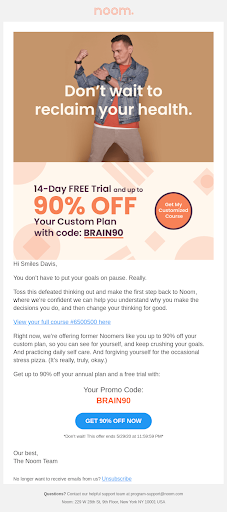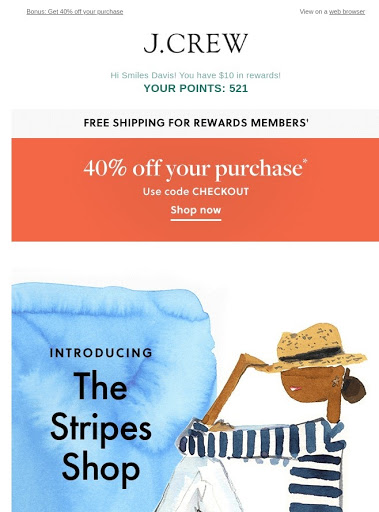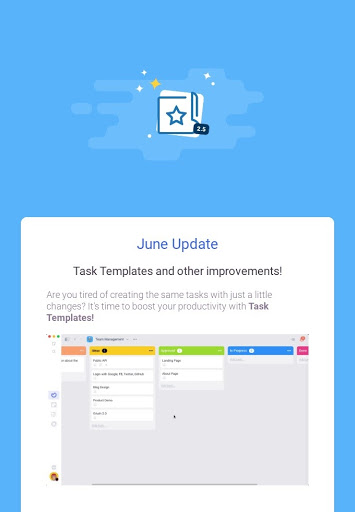

Quick Links
Quick Links
Did you know that email is one of the most cost-effective ways to market your business? According to Campaign Monitor, email marketing has a 4440% ROI.
The type of campaigns, their frequency, and content vary depending on your industry and goals. For example, a SaaS newsletter is completely unalike an e-commerce offer. However, there is one rule that equally makes all email marketing campaigns successful. They have to deliver value to their recipients.
In this post, we will break down some email marketing best practices that will help your email campaigns see better results.
Start by Planning a Campaign
Treat email marketing as a project and start by thoroughly planning it. Define your goals first, and then select metrics that will help measure their completion.
Setting a campaign goal will also help you with sending the right type of emails.
For example, you build a project management software, and recently started a podcast and a blog about effective remote work. You wish to promote your content as well as augment and engage your audience. What should you send then?
- Welcome email to greet new subscribers.
- Newsletter featuring your recent publications.
- Special promo campaigns for subscribers to engage them.
Assess your subscriber list, check the open rate, bounces, and unsubscribes, as well as click-through rate for each email to get a better understanding of what your subscribers are interested in.
If you run an online store selling jewelry, for instance, you can send the following emails:
- Welcome email to greet new customers and build relationships.
- Abandoned cart email to drive more purchases.
- Seasonal promo campaigns.
- New product launch messages.
While the type of emails differs a bit, email metrics will be quite the same. You should also track opens, clicks, and unsubscribes. In addition, you should measure conversions for your promo campaigns and product launches to understand whether your emails lead to purchases.
How to Make Your Campaigns Better
While we are talking about email marketing campaigns in this post, we strongly recommend to put marketing effort to all types of campaigns that your company sends. Whether it’s a cold email or a transactional message, such as order confirmation or a password reset, pay attention both to branding and tone and voice of each template. Keep all your messages consistent to increase brand awareness and build trust.
Personalize Your Emails
Personalization means sending emails that are crafted according to preferences and needs of each subscriber. The first thing that comes to your mind when thinking about personalization, most likely, is a greeting by name. This is true, it’s the most simple case. You can add a name to any type of campaign with any sending method you use. Almost everyone likes it when somebody is calling their name. Don’t miss this opportunity to establish connection with your audience.
The more advanced cases include sending behavior-based emails. Those can be triggered by actions taken on your website, such as viewing specific offers, making search queries, and so on. You can also prepare campaigns for customers’ birthdays, anniversaries, or goals reached with your service.

Source: Really Good Emails
Comprehensive personalization is usually a part of automated marketing that can be implemented with such tools as CRM systems or marketing automation platforms.
Use all available methods to gather information about your customers. Opportunities depend on your type of business, but the basic metrics can include the following:
- Where do they live? How can your offers be tailored to their location? For example, prepare promo campaigns for local holidays.
- What do they do for a living? Are you able to deliver something that can improve their work experience?
- What are their hobbies or interests? Can there be an opportunity for a partner marketing campaign?
Segment Your Subscriber List
As a part of your email marketing efforts, you can use groups or tags to categorize your customers and send them personalized campaigns.
We all like personal touch, both in offline and online services. Personalized emails help build relationships with your audience and make them feel that you take care of them.

Source: Really Good Emails
Pay Attention to Design
Today it’s extremely easy to design a message. There are dozens of email templates available online, specialized tools that help you craft a beautiful email, and even email frameworks designed for building nice and clean messages. Here we list a few points to keep in mind when crafting your template.
- Keep it simple. For some emails adding your logo only can be enough. Put meaningful images or animations and clear call to action buttons. Your goal is to deliver an easy to comprehend content that is associated with your brand. The more elements and complicated styles you use, the higher chances that your email won’t be displayed properly in some email clients.
- Take care of accessibility. Make your emails compatible with screen readers by keeping logical structure, adding alt text to images, and clear descriptions to links. Use the contrasted color scheme to make sure your text is visible in the background.
- Don’t exceed the recommended email size. The common email template size width is 600 – 640 pixels. It will look good in every email client. The general email size should be up to 102 KB to increase chances of being delivered to the main inbox folder and be fully displayed.
- Test responsiveness. Email template suppliers nowadays take care of responsiveness by default. But still, don’t forget to test your email across popular devices and make sure it looks good on a desktop, tablet, and smartphone.

Source: Really Good Emails
Make Your Email Header Visually Attractive
Email headers are part of the whole email design, but we put it as a separate paragraph because it requires special attention. Email header is the first thing the email recipient sees when opening your email. And in many cases it is the only thing they see due to its size and template layout, especially, on screens of mobile devices.
This is why according to the best practices it is recommended to include the main idea of your message to its header. About 350 pixels is usually visible above the fold. Let’s review several examples.

Source: Really Good Emails
This is a good header sample. The most important information is displayed on the first screen, it prompts for an action and further reading. The link to a web version is also included for those cases when the email is not rendered properly in the email client.

Source: Really Good Emails
This is an email template that we wouldn’t recommend to use. The header contains a large space that doesn’t explain the purpose of the message. The text part may be not visible on some screens. There are no links to the sender’s website as well as to the online version of this email.
Focus on What Your Subscribers See Before They Open Your Email
What do you do when you receive a new message? You look at the sender’s name, email subject, and its preview text to decide whether you should open it or press “Delete” or even “Mark as spam”. Keep this in mind when preparing your email campaign. All the effort you put into crafting a great template will be a waste of time if no one opens your email.
-
- Sender’s name. We often see email notifications from “no-reply” addresses, however, we suggest using the personal approach. No-reply email addresses is one of spam signs for some filters. In addition, it is a really nice practice to include your name and an option to reply to your email. Compare “Diana from Mailtrap <diana.le@mailtrap.io>” and “Mailtrap <no-reply@mailtrap.io>”.
- Subject line means a lot for our decision on opening the message. It should be clear and engaging. It is recommended to keep it around five words, experiment with emoji, and avoid spam words, such as 100%, buy now, risk-free, luxury, etc.
- Preview text is the next 40-140 symbols after a subject line that you see in your email client before opening a message. It should support the idea of your email and nudge recipients to open it. It can be compared to the article name and its brief description when you look for some information in Google and decide which website you should open.
Here is a screenshot of the inbox tab in Gmail. It contains messages from six different senders, here’s what they have in common:
- Sender’s name is a brand name, and a personal name included in some cases.
- Subject line is short and clear, directly explaining the purpose of this email.
- Preview text briefly describes the content of the message.
Test Your Emails
This is quite obvious that you should preview your template before sending it to real recipients. Just quickly reminding what to focus on:
- Make sure email headers look as expected, including sender, recipient, and subject line.
- Check whether email template design looks good on all types of devices that your recipients can use to read emails. It is usually referred to as a responsiveness test.
- Examine email personalization elements. Is this a right type of campaign for this recipient? Does the recipient name look right? Is it indeed Ann, but not ^$^&**!!, or John?
- Click every link and button to be sure they lead to the right pages. Read your email copy.
- Use A/B tests to find what works better for your campaigns. Try different subject lines, sender names, email headers, greetings, and see how they impact on the open and click through rates.
Work With Your Subscriber Lists
Sending right messages to the right people is the golden rule of effective campaigns based on customer-behavior. You should effectively manage your subscriber lists to make it work.
Bounce rate, unsubscribes, spam complaints (God forbid!), and unengaged recipients affect email deliverability and your sender’s reputation.
We hope you know that you never should buy email lists. They are usually of low quality and what is even more important, this is a violation of various privacy regulations. Now the most common regulations include GDPR, CAN-SPAM, and CCPA. The main rule is getting a recipient’s consent before sending email marketing campaigns. It is recommended to use double opt-in and put an unsubscribe link along with the information about the sender to your emails.
It is also a good idea to use email verification services to make sure that addresses on your list are still valid, as well as regularly review and clean up your subscriber database.
Use Great Email Marketing Tools
To follow all the recommendations we have given in this post, you should use the right email marketing tool. There are hundreds of email marketing tools, platforms, and services. How to choose the one you need?
To make the right choice, you should define which features are crucial for you. With the advanced functionality, the price increases. However, if you already use or plan to incorporate a CRM system, it can be efficient to have the email marketing integrated.
If you plan to send monthly newsletters only, then you don’t need cutting-edge automation. In this case, pay attention to sign up forms for collecting subscribers data and integrating it directly with the sending system. For simple campaigns, a built-in drag and drop email template builder will also come in handy.
For e-commerce websites it is important to send behavior-based email marketing campaigns. In this case, check the tools that offer highly customizable triggers and funnels.
It’s Time To Put These Email Marketing Best Practices To The Test
As you get ready to start your email marketing campaign, remember that adding value to your customers is the most important thing. People are busier than ever these days, and if they’re going to open an email, it needs to be worth their time.
If you’re looking for someone to help you craft high-quality emails, FreeUp can help you find a freelance email marketer who can work with you to find the perfect message for your customers.

